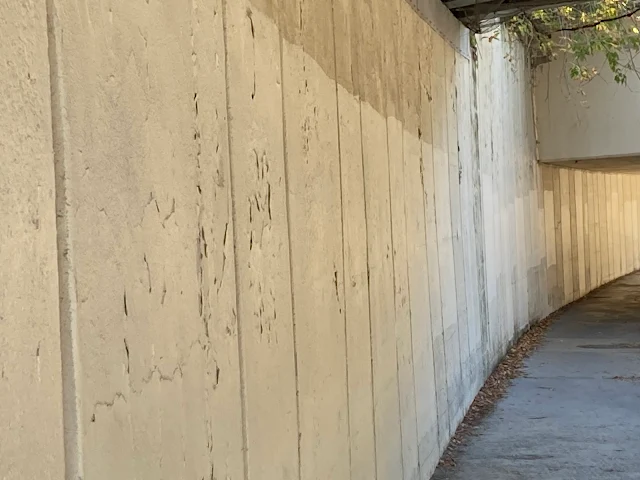Looking out of a basement window, seeing several robins in the bird bath and, a few feet away, a squirrel drinking water from a dish. For a while during Covid we had a quarantine, you would be fined if caught outside after eight p.m. except if you were walking your dog (you can’t make up this stuff); I remember standing by this same basement window, looking outside, and thinking how lovely and quiet it was. Do other people look back on Covid and question the whole thing?
Made in Montreal
Morrissey's archive
Monday, October 21, 2024
Sunday, October 20, 2024
Alexis Nihon Plaza, 20 October 2011
Saturday, October 19, 2024
The journey, underpass
Wednesday, October 16, 2024
Finding one’s voice in poetry
 |
| 4 October 2024 |
All poets need to find their voice, this requires talent, perseverance, and commitment to writing. From when I began writing poetry, in 1965, I knew I had to find my voice, I knew I had to write poems that I could stand behind --poems that were true to my inner self-- and those poems would accurately express the experiences that had formed or created my life. For me, the discovery of my voice in poetry was an important development in my work as a poet; I knew this instinctively, and I spent years writing every night until I finally wrote a "real" poem.
The journey to being a poet includes writing, study, reading, and having a few poet friends; it's a journey in that you don't know where you are going until you get there, and you never know if you will write a genuine poem until you write one. Discovering my voice in poetry was a breakthrough in my writing. In my early twenties I had written poems, for instance “there are seashells and cats”, and this was my true voice. This discovery of my true voice is shown in the poems in my first book, The Trees of Unknowing (Vehicule Press,1978); these were my first poems that I felt were genuine poems, poems that I could stand behind. Finding one's voice in poetry doesn't mean that you will stay writing the same way, what you say changes and how you say it changes, but that is only after you find your voice; another important poem, in my body of work, is “Divisions”, it was written over three days in April 1977.
_________
November 2012 – June 2013
Revised October 2024
Montreal
Monday, October 14, 2024
"Poets" by The Tragically Hip
 |
| January 2021 |
Saturday, October 12, 2024
Friday, October 11, 2024
Wednesday, October 9, 2024
Saturday, October 5, 2024
Two newly discovered paintings by Darrell Morrisey
 |
| A newly discovered painting by Darrell Morrisey |
 |
| A second painting, seen above, is on the reverse side of the painting, "L'église Notre-Dame-de-Grâce",1927 - 1930, by Darrell Morrisey |
 |
| Label of framer on this painting |
 |
| L'église Notre-Dame-de-Grâce, located at 5333 Avenue Notre-Dame-de-Grâce, Montreal; photo from 1890 |
 |
| Photographs of L'église Notre-Dame-de-Grâc, from the church website |
The front is a simple countryside landscape with the tree and the hay wagon . Signed D Morrisey, and measure 13 1/2 x 11 1/4 in. framed. The other side of the board shows a religious building to be identified, unfortunately someone wrote some numbers, but it looks written in pencil. It bears a label for Maison Morency Frères , when they were on Ste-Catherine at their beginning (opened 1906) , they had two other locations afterward , the most famous address was when they were on St-Denis street near De Maisonneuve. (15 September 2024)
At first I wondered where this landscape had been painted, there are no recognizable geographical features in the painting but there is the hay wagon. Darrell visited France several times and in Quebec she often painted rural country scenes, but I wondered about the hay wagon, it is a minor point but all I had to go on. Were hay wagons similar to the one shown in her painting used in Quebec? The answer is that this type of hay wagon was used in both Quebec and in France, so it could have been painted in either place. Personally, I would place this landscape in Quebec.
It is Darrell's painting of the church that interests me more than the landscape, it is the painting that I would hang in my living room if I owned this painting. At first I wondered if it was a painting of a church in Spain, it didn’t look like a traditional Quebec church. I did a reverse image search on the painting and one of the many images that came up was of L'église Notre-Dame-de-Grâce here in Montreal. Well, this was a happy coincidence and quite an auspicious discovery, from 1976 to 1979 I lived on Northcliffe Avenue just two block east of this church; I spent many hours waiting for a bus, to the Vendome Metro station, standing across the street from L'église Notre-Dame-de-Grâce; unfortunately, I didn’t pay enough attention to the church. And now, here it was in Darrell Morrisey’s painting.
Construction of L'église Notre-Dame-de-Grâce began in 1851 and the church was inaugurated on 18 September 1853, exactly 153 years ago. The architect of the church was John Ostell, an English architect who had married a Roman Catholic woman and converted to Catholicism; he also designed the two towers on the prestigious and historical Notre Dame Basilica facing Place d'Armes. There is a crypt beneath the church and Jacques Viger, the first mayor of Montreal, is buried there. Guido Nincheri designed stained glass windows for L'église Notre-Dame-de-Grâce; for some time there has been a growing interest in Nincheri's work, his studio is in Montreal's Hochelaga-Maisonneuve district; stained glass windows by Nincheri can be seen at St. Michael the Archangel Church in Mile End in Montreal, at L'église Saint-Léon de Westmount, and at many other churches. Mélanie Grondin's The Art and Passion of Guido Nincheri (Vehicule Press, 2017) is an excellent biography of Nincheri's life.
But there is more. I noticed that the bell tower on the right side of the church is not present in old photographs of the church. The bell tower is a relatively new addition to the church, it was constructed in 1927, and this helps us date the painting; Darrell must have painted the church between 1927 and the date of her passing in 1930.
We can even narrow down when the painting was done to just one year as her presence in Montreal was infrequent between 1927 and 1930. In the fall of 1926 Darrell and her parents traveled to the UK, they had planned a tour of Britain and France now that T.L. Morrisey, Darrell's father, had retired from the insurance business; however, shortly after arriving in the UK, T.L. Morrisey died. Then, Darrell and her mother returned to Canada and sold Hazelbrae, the family home on Church Hill Avenue. During 1927 and 1928 Darrell was busy with her art, it was a time of creativity and being active in the art community. In 1927 she exhibited in the RCA members exhibition; a year later, in 1928, she exhibited her paintings with the Art Association of Montreal (later the Montreal Museum of Fine Arts). She even illustrated an advertisement for a cook book, Les Secrets de la bonne Cuisine (the advertisement was published in LaPresse, 22 October 1928), by Soeur Sainte-Marie Edith.
On 18 August 1928, Darrell and her mother traveled to England on the Duchess of Bedford. On a ship's passenger list Darrell lists her occupation as “artist”. After Darrell's mother returned to Montreal Darrell stayed on in London, she was a resident there for almost two years, from August 1928 to 6 July 1930 when she returned to Montreal. We don’t fully know what happened during those two years. Then, Darrell returned to Montreal for an unusually short visit, from July to September 1930, and she returned to the UK on 11 September; she traveled alone and listed her profession as "none". A month later, Darrell Morrisey died, on 22 October 1930, at London, England, where she had been living at 18 Weech Road in Hampstead. It is an anticlimax to this narrative to say that the painting must have been painted between January 1927 and August 1928, probably the summer of 1927 or the summer, to August, of 1928.
And now, I must thank Mr. Charles Lecour for contacting me about this painting; I hope he enjoys it as much as I have enjoyed seeing it and researching and writing about the painting of an artist who was unknown and forgotten just fifteen years ago, and whose charisma can still be felt almost a hundred years after her passing.
For more information on Darrell Morrisey:
https://archive.org/details/DARRELLMORRISEYAForgottenBeaverHallArtistByStephenMorrissey/mode/2up
https://stephenmorrisseyblog.blogspot.com/search?q=darrell+morrisey













.JPG)
.JPG)
.JPG)
.JPG)
.JPG)
.JPG)
.JPG)
.JPG)
.JPG)
.JPG)























